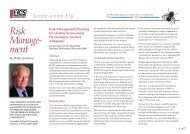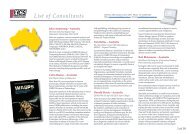Manual for Diagnosis of Screw-worm Fly - xcs consulting
Manual for Diagnosis of Screw-worm Fly - xcs consulting
Manual for Diagnosis of Screw-worm Fly - xcs consulting
You also want an ePaper? Increase the reach of your titles
YUMPU automatically turns print PDFs into web optimized ePapers that Google loves.
The egg <strong>of</strong> C. bezziana is white, 1.25mm long and 0.26mm in diameter, with a cylindrical<br />
shape, rounded at both ends but with one (anterior) end more tapered. Hatching lines<br />
enclosing a median strip occur along the entire length <strong>of</strong> the dorsal surface <strong>of</strong> the egg,<br />
occupying about 20-30 per cent <strong>of</strong> the width <strong>of</strong> the egg and bifurcating at the micropyle to<br />
produce a horse-shoe shaped structure (Fig. 11). Within the median strip, there is a plastron<br />
network which facilitates respiration in the developing embryo. The shell or chorion <strong>of</strong> the egg<br />
is comparatively thick and hard. On squeezing with <strong>for</strong>ceps, the rupturing <strong>of</strong> the chorion is<br />
quite audible.<br />
Figure 11: Egg mass and egg <strong>of</strong> Chrysomya bezziana.<br />
3.3 Larvae<br />
Agriculture, Fisheries and Forestry - Australia<br />
There are three instars during development <strong>of</strong> C. bezziana larvae. The first two instars each<br />
occupy one day and the third and final instar lasts three to five days. They have been<br />
described by Kitching (1976). There are 12 visible segments: the head, three thoracic and<br />
eight abdominal segments. The posterior spiracles <strong>of</strong> first, second and third instar larvae<br />
each have one, two or three openings respectively to the tracheal system (Fig. 12).<br />
First Instar (Figs. 12,13)<br />
The first instar larva is white, 1.6mm long and 0.25mm in diameter, round in cross section,<br />
without obvious protuberances or papillae, and with bands <strong>of</strong> spines on most <strong>of</strong> the body<br />
segments. The spines are thornlike, black in colour and backwardly directed. The prothoracic<br />
spiracle is a small, simple opening. There is a pair <strong>of</strong> posterior spiracles each with a single<br />
opening but with no peritreme.<br />
Second Instar (Figs. 12,13)<br />
Second instar larvae are white to cream coloured, 3.5-5.5mm long and 0.5-0.75mm in<br />
diameter. Spines in bands, thornlike, black, directed backwards, all with a single point.<br />
Protharacic spiracles are non-functioning (occluded) with 4-5 stubby, lightly sclerotised<br />
papillae or branches. Each <strong>of</strong> the pair <strong>of</strong> posterior spiracles is surrounded by a heavily<br />
sclerotised peritreme, dark brown to blackish in colour, which is incomplete or nearly so<br />
dorsally and ventrally, and has 2 slit-like spiracular openings.<br />
11




